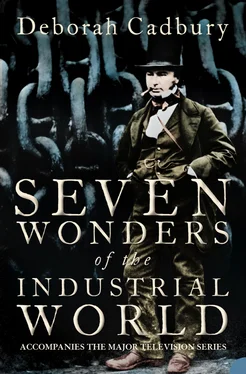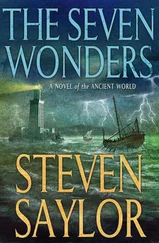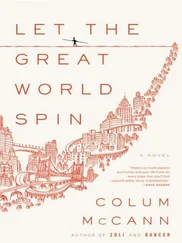The launch place of the Leviathan presented a chaotic picture to Charles Dickens. ‘I am in an empire of mud … I am surrounded by muddy navigators, muddy engineers, muddy policemen, muddy clerks of works, muddy, reckless ladies, muddy directors, muddy secretaries and I become muddy myself.’ He noted that ‘a general spirit of reckless daring’ seemed to animate the ‘one hundred thousand souls’ crammed in and around the yard, upon the river and the opposite bank. ‘They delight in insecure platforms, they crowd on small, frail housetops, they come up in little cockleboats, almost under the bows of the Great Ship … many in that dense floating mass on the river and the opposite shore would not be sorry to experience the excitement of a great disaster.’
In the dull light of the November morning the scene that greeted Brunel as he emerged from his makeshift quarters was one of confusion and noise, with uncontrollable crowds swarming over his carefully placed launch equipment. All of fashionable London, displaying intense curiosity, expecting to be amused, charmed, and hopefully thrilled, was taking the air in Napier shipyard. Then, almost farcically, in the midst of preparations, a string of unexpected distinguished visitors turned up in all their finery, first the Comte de Paris and then, complete with a retinue resplendent in gold cloth, the ambassador of Siam. A half-hearted attempt at a launching ceremony saw the daughter of Mr Hope, the chairman of the board, offering the token bottle of champagne to the ship. Brunel refused to associate himself with it. She got the name wrong, christening the ship ‘Leviathan’ , which nobody liked since all of London had already decided on the Great Eastern .
The whole colourful funfair scene was terribly at odds with the cold, clinically precise needs of the launching operation. Brunel felt betrayed, as he later told a friend: ‘I learnt to my horror that all the world was invited to “The Launch”, and that I was committed to it coûte que coûte. It was not right, it was cruel; and nothing but a sense of the necessity of calming all feelings that could disturb my mind enabled me to bear it.’
Brunel had no alternative but to make the attempt in spite of the difficulties. He stood high up on a wooden structure, against the hull, his slight figure wearing a worn air, stovepipe hat at an angle, habitual cigar in his mouth. He held a white flag in his hand, poised like a conductor waiting to begin the vast unknown music.
As his flag came down, the wedges were removed, the checking drum cables eased, and the winches on the barges mid-river took the strain. For what seemed an eternity, nothing happened. The crowd, which had been quiet, grew restive. Brunel decided to apply the power of the hydraulic presses. Suddenly, with thunderous reverberation, the bow cradle moved three feet before the team applied the brake lever on the forward checking drum. Immediately, accompanied by a rumbling noise, the stern of the great hull moved four feet. An excited cry went up from the crowd: ‘She moves! She moves!’ In an instant the massive cables of the aft checking drum were pulled tight, causing the winch handle to spin. As the winch handle ‘flew round like lightning’, it sliced into flesh and bone, and tossed the men who were working the drum into the air like flotsam. The price the team paid for not being entirely awake to the quickly changing situation was four men mutilated. Another man, the elderly John Donovan, sustained such fearful injuries he was considered a hopeless case and was taken to a nearby hospital where he soon died.
Later that afternoon, Brunel tried to move the hull once more but a string of minor accidents and the growing dark persuaded him to finish for the day. In the words of Brunel’s 17-year-old son Henry, ‘the whole yard was thrown into confusion by a struggling mob, and there was nothing to be done but to see that the ship was properly secured and wait till the following morning’.
The spring tide had come and gone, the next one was not for another month; another month of extortionate fees while the ship lay on the slipway. Brunel was determined to get the ship completely on to the launch-ways as soon as possible. He was very concerned that while the ship was half on the building slip (whose foundation was completely firm) and half on the launch-ways (which had more give) the bottom of the hull could be forced into a different shape. His urgent task was to get the ship well down the launch-ways to the water’s edge in case the hull started to sink into the Thames mud under its immense weight. The fiasco of 3 November at least provided information on how to manage the launch more effectively. Some alterations were made to improve the equipment and another attempt at the launch was made on the nineteenth. This was a huge disappointment with the hull moving just 1 inch. Clearly, more would have to be done.
The winches on the barges mid-river had been ineffective and all four were now mounted in the yard, their cables drawn under the hull and across to the barges; but even chains of great strength and size broke when any strain was put on them. ‘Dense fog made it almost impossible to work on the river,’ observed Henry Brunel. ‘Moreover, there seemed a fatality about every attempt to get a regular trial of any part of the tackle.’ Two more hydraulic presses were added to the original two, giving a force of 800 tons at full power.
By 28 November, Brunel felt confident enough to try to move the Great Ship once more. From a central position in the yard, Brunel signalled his instructions with a white flag. The hydraulic presses were brought up to full power and, to the accompaniment of terrifying sounds of cracking timber and the groaning and screeching of metal, slowly the ship moved at a rate of one inch per minute. As before, though, the tackle between the hull and the barges proved unreliable and Captain Harrison and his team found themselves endlessly repairing chains. In spite of the difficulties, by the end of the day the ship had been moved fourteen feet and there was renewed hope of floating the ship on the high tide of 2 December. An early start on 29 November saw the river tackle yet again let them down and the four hydraulic presses pushed to their maximum could not move the ship. Hydraulic jacks and screw jacks were begged and borrowed and by nightfall another 8 feet had been claimed so that by the thirtieth the ship had moved 33 feet in total and hope now had real meaning. But then one of the presses burst a cylinder, which killed off any possibility of a December launch.
Brunel would not be defeated though, and throughout December he carried on inching the colossal black ship down the launch-ways. Each day it was becoming more reluctant to start. ‘While the ship was in motion,’ noted Henry Brunel, ‘the whole of the ground forming the yard would perceptibly shake, or rather sway, on the discharge of power, stored up in the presses and their abutments.’ In the freezing fogs of December and January, the hundreds of workers were heard, rather than seen, as the yard echoed with the sounds of orders and endless hammering. The gangs sang to relieve their boredom as they mended the chains. At night, gas flares lit the scene and fires burned by the pumps and presses to stop them freezing up. With the small figures of the workers beneath the huge black shape in the mist, which was red from the many fires, it gave the impression that some unearthly ritual was being enacted on this bleak southerly bend in the Thames.
Brunel was coming to the conclusion that the pulling power he had hoped to obtain from the barges and tugs on the river was not going to be enough and that his best hope lay in providing much more power to push the ship into the river. The railway engineer, Robert Stephenson, a friend who had come to view the operation, agreed and orders were placed with a Birmingham firm, Tangye Bros, for hydraulic presses capable of much more power.
Читать дальше












